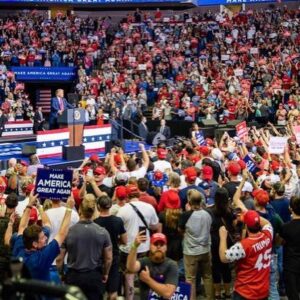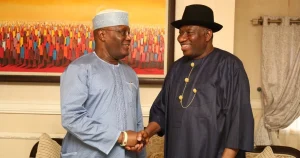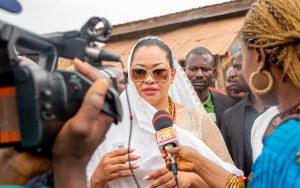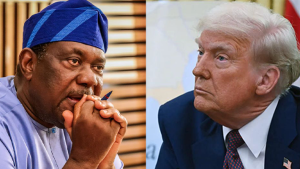Trump campaign blames protesters for disappointing turnout at Tulsa rally
Trump campaign blames protesters for disappointing turnout at Tulsa rally
Slipping in polls, the president hoped to reset his campaign with first rally since coronavirus outbreak began.
TULSA – President Donald Trump is hoping to outrun the coronavirus pandemic as he bids for reelection in 2020. His return to the campaign trail Saturday night in Tulsa, Okla. demonstrates just how difficult that’s going to be.
Trump skipped a planned appearance outside of the BOK Center in Tulsa, Okla., which Campaign Spokesman Tim Murtaugh blamed on “radical protestors, coupled with a relentless onslaught from the media,” who “attempted to frighten off the President’s supporters” with their warnings about the pandemic risk.
Reporters on the scene, however, denied seeing large numbers of people turned away from the overflow stage. Inside the 20,000-person BOK Center, meanwhile, whole sections of the arena remained empty. Health experts had issued increasingly stark warnings in the lead up to the rally, while a June 15 editorial in the Tulsa World argued it was “the wrong time” to hold a campaign gathering.
The disappointing turnout is a blow to Trump and his Republican allies, who hoped the rally would kick start a new phase of the campaign after a politically brutal spring. National and swing-state polling show Trump trailing presumptive Democratic presidential nominee Joe Biden, amid mounting criticism of the president’s handling of both the coronavirus and the protests against police brutality sweeping the nation.
Trump had bragged earlier in the week that the campaign had received nearly a million ticket requests for the rally — his first after a three-month hiatus due to the pandemic, which has killed more than 121,000 Americans.
CNN, however, reported that anti-Trump organizers on social media were encouraging people to register for the rally and then not show up. In the days leading up to the event, Trump campaign officials tried to determine how many of the one million sign ups were fakes — a figure they ultimately determined was in the hundreds of thousands. But they said they still expected a massive crowd.

Some Republicans involved in the re-election effort said they feared an internal backlash over the snafu. The president has long been known to take his crowd sizes seriously and had viewed his Tulsa rally as a turning point.
“You are warriors!” the president told the crowd as he began his remarks. “We had some very bad people outside. They were doing bad things.”
The thousands of people in the arena, many of whom lined up days earlier, erupted in what felt like a primal scream of pent of excitement and emotion, months in the making. T-shirts emblazoned with “Trump 2020,” “MAGA,” and “defend the police” dotted the crowd, but few wore the face masks provided by the campaign.
The president then launched into a 90-minute speech that hit familiar targets — “Sleepy Joe” Biden, the media, the “radical left,” and the Washington, D.C. swamp — while labeling his supporters as insurgents, ready to take on the establishment and every group of people who oppose his administration.
In a return to controversial rhetoric he used in March, Trump referred to the coronavirus as the “China Virus” and “Kung-Flu,” the latter a term one of his own advisers acknowledged was offensive. And he downplayed the impact of the virus, saying, “I have done a phenomenal job with it. I saved hundreds of thousands of lives.”

The president also said he told his team to slow down testing for Covid-19, the disease caused by the novel coronavirus, blaming the increase in tests for the recent rise in infections across the south and west of the country, including in Oklahoma.
The entire scene was soaked in controversy. The nation’s largest indoor gathering in three months was a rejection of the Trump administration’s own warnings about public events. Six members of the campaign’s advance team who worked to set up the rally tested positive for Covid-19 and have been forced to quarantine.
And the rally comes amid nationwide protests — including in Tulsa — over systemic racism. The event was initially announced to take place on Juneteenth, a celebration of the end of slavery in the United States, before the campaign moved the date last week after mounting criticism. The rally took place about a mile from the site of the Tulsa Race Massacre – one of the worst racist attacks in American history in which white mobs burned the black community of Greenwood, known as “Black Wall Street” on June, 1, 1921.
Marq Lewis, a Tulsa resident and community activist with We the People Oklahoma called the visit purposefully inflammatory. “We’re already tender and emotions are high. People feel like they can’t really celebrate their Juneteenth the way they want to celebrate it without the backdrop and the shadow of Donald Trump.”
Trump, for his part, decried the actions of protesters, particularly those that have torn down or vandalized Confederate statues and other memorials to figures like Christopher Columbus and Thomas Jefferson. “The unhinged left wing mob is trying to vandalize our history, desecrating our monuments, our beautiful monuments, tear down our statues and punish, cancel and persecute anyone who does not conform to their demands for absolute and total control,” he lamented.
“That’s why we’re here, actually. This cruel campaign of censorship and exclusion violates everything we hold dear as Americans. They want to demolish our heritage so they can impose their new oppressive regime in its place. They want to defund and dissolve our police departments. Think of that.”
The president arrived in Oklahoma at the same time that the state has seen a spike in Covid-19 infections, with 352 new cases in the state on Friday alone — the second-largest one-day jump during the crisis. And the indoor mass gathering went against the recommendations of health experts in Oklahoma and across the nation.
While trying to sidestep the politics of the rally, local health officials continued to remind Oklahoma residents and other rallygoers of the dangers of large-scale events during the Covid-19 pandemic. “As outlined by the CDC, individuals looking to attend any large-scale gathering will face an increased risk of becoming infected with Covid-19 and becoming a transmitter of this novel virus,” a spokesman for the Oklahoma State Department of Health said in a statement ahead of the event.
“I think it’s an honor for Tulsa to have a sitting president want to come and visit our community, but not during a pandemic,” Tulsa Health Department Director Brad Dart told the Tulsa World earlier in the week. “I’m concerned about our ability to protect anyone who attends a large, indoor event, and I’m also concerned about our ability to ensure the president stays safe as well.”
The Trump campaign sent mixed messages about whether the rally would be safe for attendees. The president told reporters this week that “everybody is going to be safe” while the registration for tickets came with an acknowledgment that “any guests voluntarily assume all risks related to exposure to COVID-19,” and couldn’t hold the campaign or the center liable.
Though the campaign handed out masks and hand sanitizer, the vast majority of attendees opted not to wear face coverings, bucking the advice of healthcare experts as they chanted, booed and laughed along with the president.
Trump made clear Saturday that he, too, is ready to put the Covid-19 crisis behind him, devoting more of his speech to hammering Democratic politicians and disputing the media coverage of his wobbly walk down a ramp at West Point earlier this month than to addressing the pandemic. Woven through his remarks was the same type of rhetoric on the economy, immigration, and other culture wars that propelled him to the White House in 2016 — and which his supporters now expect. The country, however, is in a much different place than it was just four months ago.













